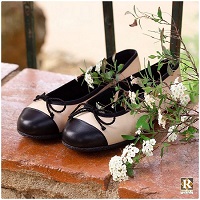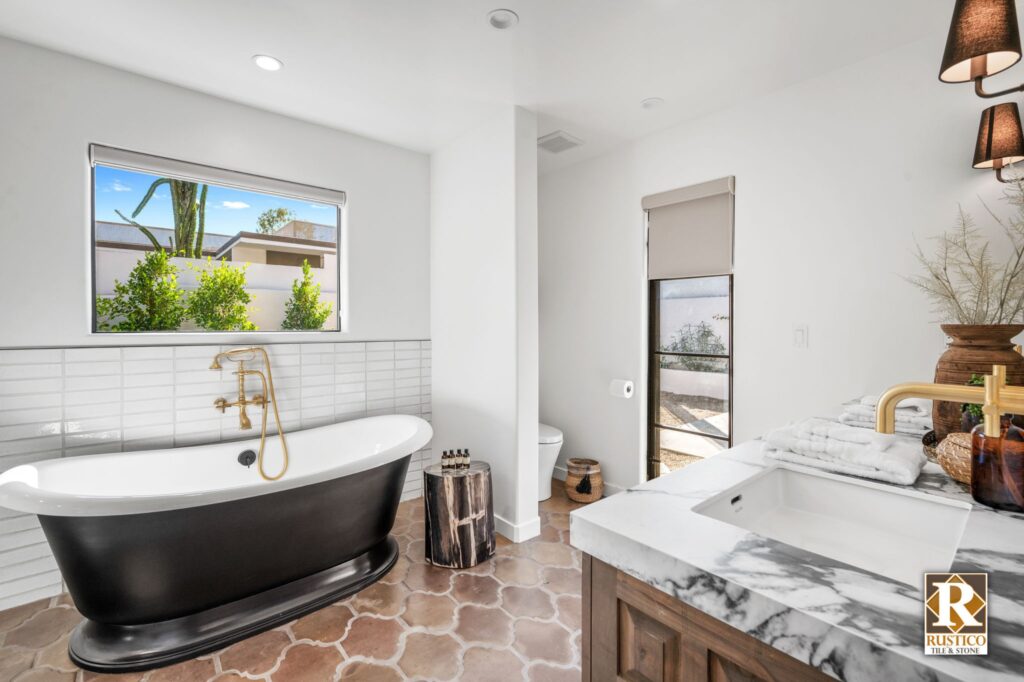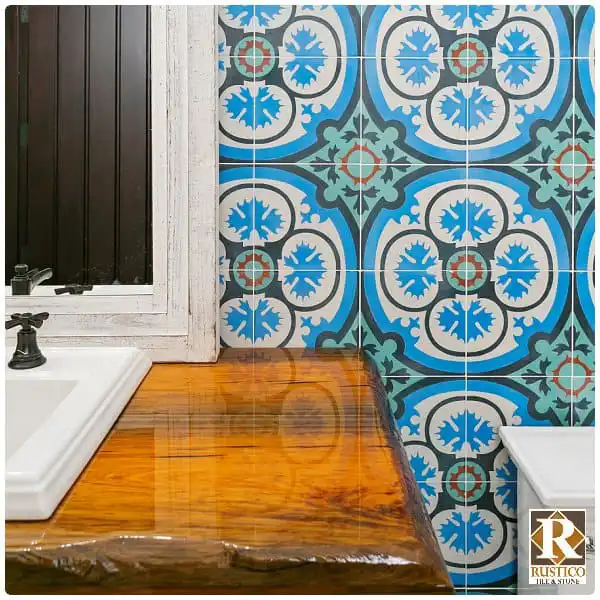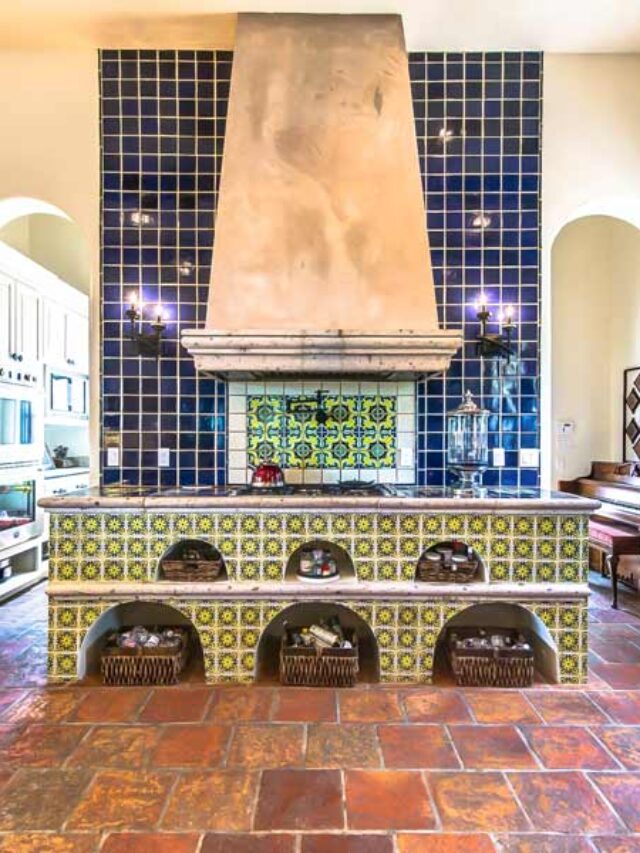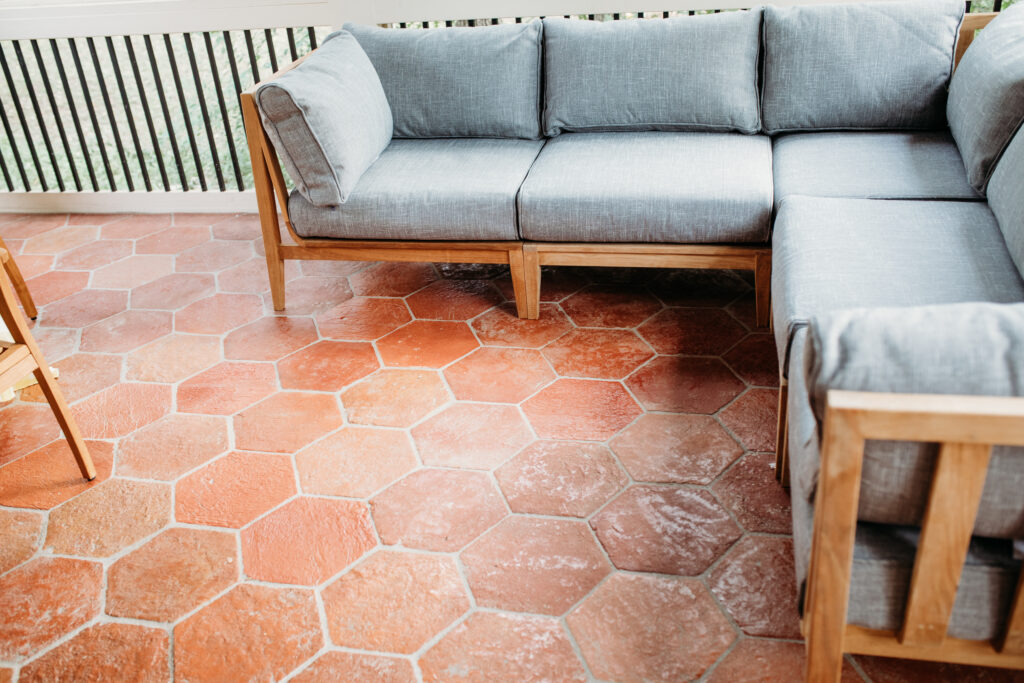- Want to Know More About Saltillo Tile Flooring?
- Is Saltillo Tile the Same as Terracotta?
- What Are the Origins of Saltillo Tile Flooring?
- How Are Mexican Saltillo Tiles Made?
- What Are Saltillo Tile Flooring Shapes & Sizes?
- What Colors Does Saltillo Tile Come In?
- What is the Difference Between Sealed and Unsealed Saltillo Tile?
- What are the Rustic Characteristics of Saltillo Tile?
- How Much Does Saltillo Tile Cost?
- How is Saltillo Tile Installed and Maintained?
- Mexican Saltillo Random Facts & Myths?
- Room Visualizer Tool
Want to Know More About Saltillo Tile Flooring?
Then you’re in the right place.
It’s REALLY tough to make flooring choices. These are permanent decisions (mostly).
This is your Ultimate Guide to Saltillo tile flooring. As it turns out, knowing some ins and outs of this Mexican tile can take some stress off your flooring decision… so you can move on to bigger decisions like paint colors.
So, let’s dive right in.
Is Saltillo Tile the Same as Terracotta?
Yes. Authentic, handmade Saltillo tile is a type of terracotta tile. In fact, it’s known to be one of the most durable terracotta tiles due to its riverbed origins in Saltillo, Coahuila, Mexico. While there are many varieties of terracotta tiles around the world, Saltillo flooring is highly sought after for its rustic characteristics, durability, and sustainable terracotta clay ingredients. Lastly, not all terracotta tiles are Saltillo tiles. By definition, only tiles that are handmade from clay found in the riverbeds of Saltillo, Mexico, can be called Saltillo tiles.


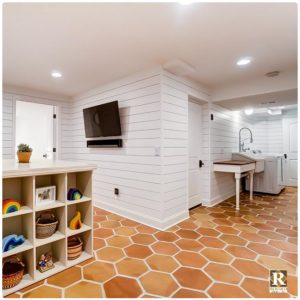

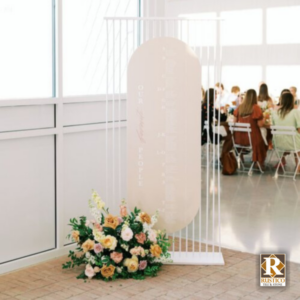

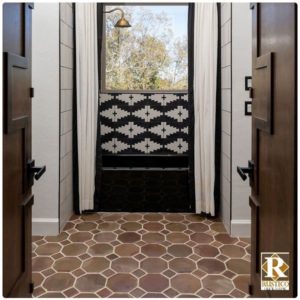



What Are the Origins of Saltillo Tile Flooring?
The origin of Saltillo tile flooring is important to appreciate the finished characteristics of handmade, rustic tile.
Let’s tackle the key facts.
Saltillo tile is made in the town of Saltillo. The state of Coahuila. And the country of Mexico. Simply put, if it’s not from this region, it is not an authentic Saltillo tile.
Saltillo tile is a type of terracotta tile. In fact, due to its raw materials origins, it’s one of the most durable terracotta tiles available.
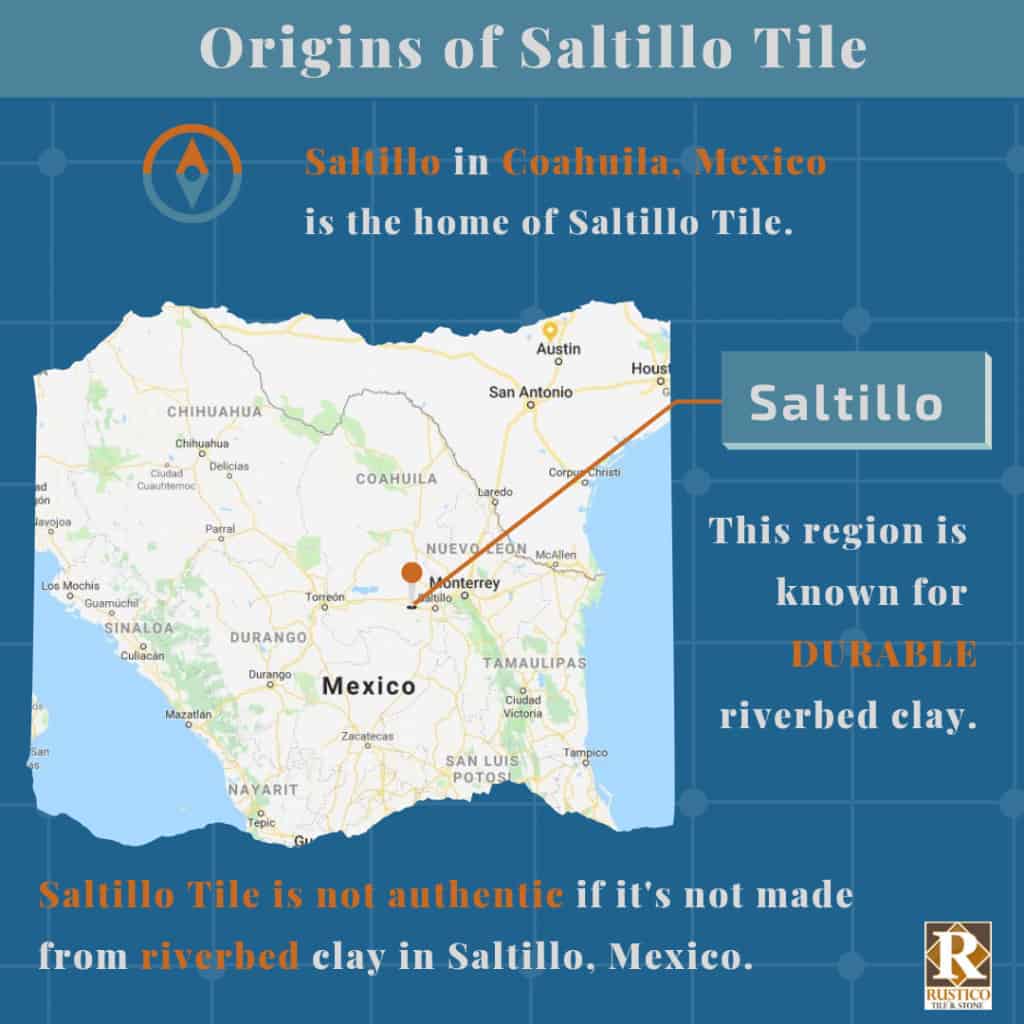
- In this area of Mexico lies a riverbed. This riverbed’s natural resource is clay. If Saltillo tile flooring is not this clay, then it’s not Saltillo tile.
- Also, this riverbed clay is known to be one of the most durable clays in the world. That’s what makes this Mexican tile an excellent flooring choice.
- Because it is clay, Saltillo tile is also known as Terracotta tile. (Not all Terracotta tile is Saltillo tile, however.) Terracotta flooring is popular in Spanish Revival Homes.
- Families in Mexico have made this tile for generations. So, while manufacturing efficiencies have improved over time, making this terracotta tile by hand has remained unchanged for generations.
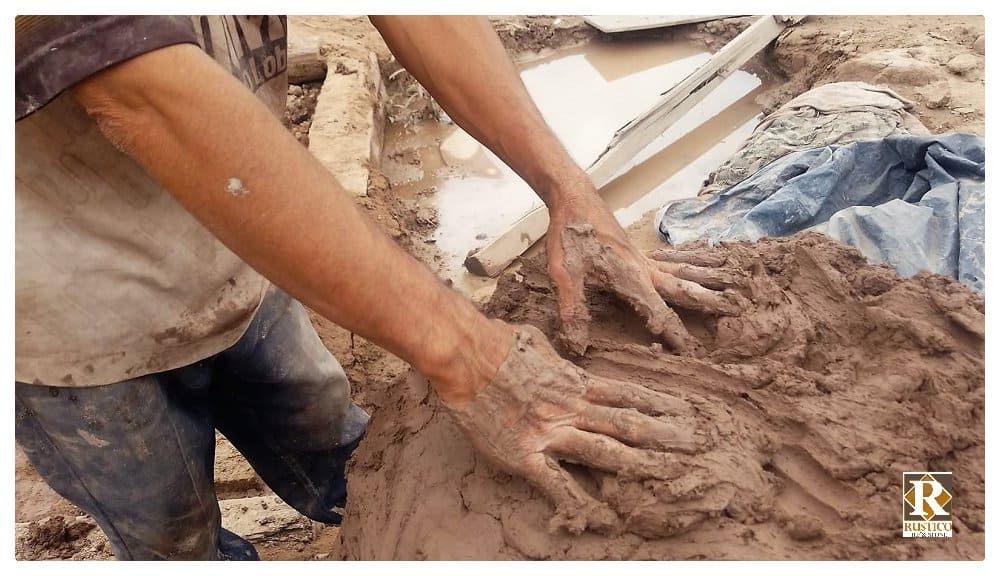
- A family structure hierarchy is deeply set into the roles of making Mexican tile. For example, young men and women have the task of digging clay from riverbeds. Meanwhile, patriarchs supervise the overnight kiln-firing process. Thus, age and experience determine an artisan’s role in manufacturing.
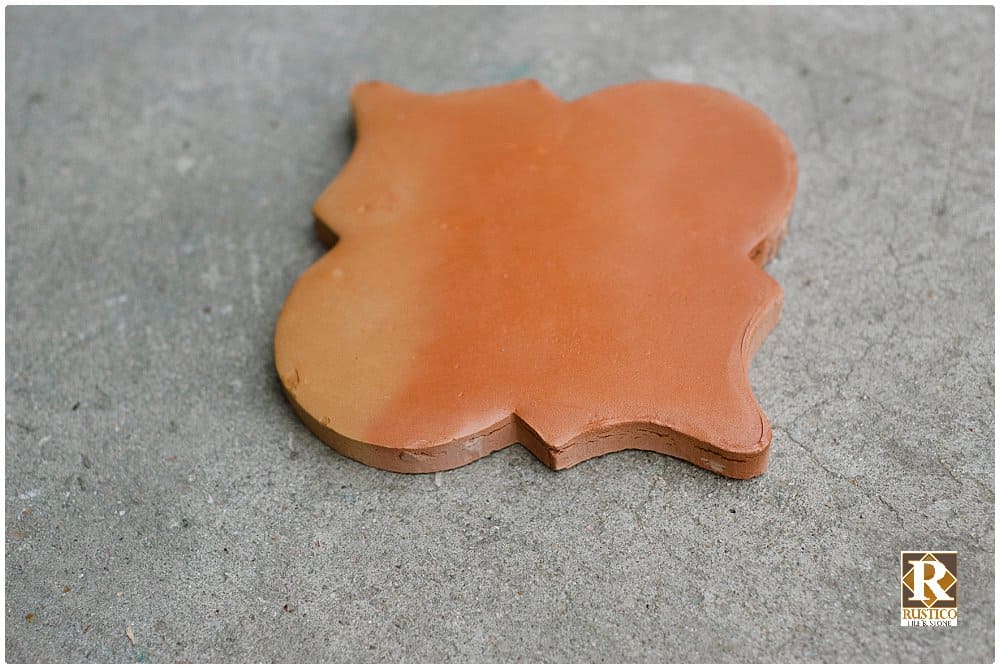
- When the criteria prevail, you have authentic, handmade Saltillo tile – the good stuff.
Considering Saltillo Flooring?
Contact us to talk tile, prices, colors, y mas. We ship this stuff worldwide!
How Are Mexican Saltillo Tiles Made?
Today, Saltillo tile manufacturers produce this Mexican tile in much the same way it was created over 100 years ago. The integrity of its hand-making process preserves tradition and culture. Each tile tells a story.
If it’s not handmade, it’s not authentic Saltillo tile. The finished look and durability cannot be mass-produced by machine manufacturing. It’s these handmade characteristics that make Saltillo tile rustic and unique. Every single tile is different.
Producers mine clay from Saltillo, Coahuila, Mexico riverbeds to begin the manufacturing process. Then, strong men and women mix water into hard, compact clay. At this stage, it’s malleable and easy to handle. This process is laborious.
Next, craftsmen hand-press small portions of clay into the tile molds. They form wet clay versions of tile.
Now, each tile is set on the ground where it bakes in the sun. Producers leave these tiles baking in the sun until they are firm enough to be stacked into a kiln.
Kiln firing is a fascinating process. Imagine a vast hole in the ground. Tiles are stacked by hand layer-by-layer from the bottom of the kiln to the top. Large producers fill this oven with up to 6,000 square feet of flooring. Then, the kiln is set on fire and left to burn for 18-24 hours. (And yes, someone monitors the fire around the clock until firing is complete.) The firing process transforms sun-dried tiles into extremely durable tiles.
Finally, after the tiles cool off in the kiln for another 24 hours, producers move each tile by hand to an area where they apply several coats of penetrating sealer. Some tiles are left unsealed for specific requests. (More on the importance of sealer below!)⇒ And, here’s another relevant point.
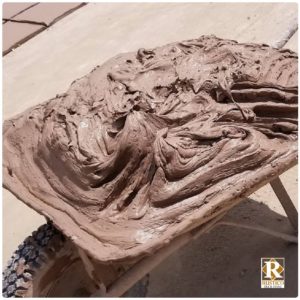

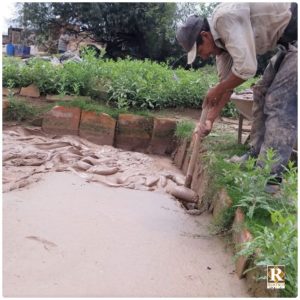

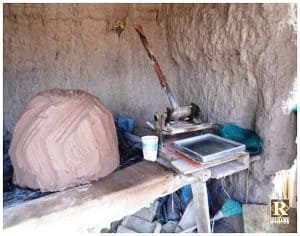

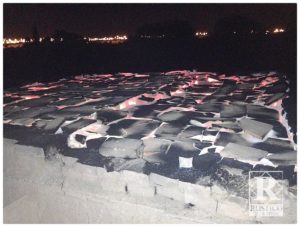

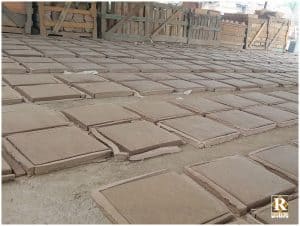

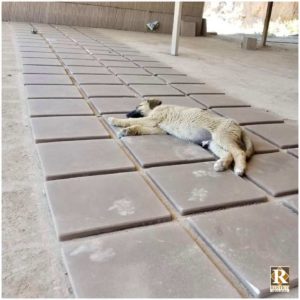

Families of Mexico create these tiles by hand in an outdoor setting. When I refer to “large” producers, this represents a consortium of families who pass along skillsets and knowledge from one generation to the next. This is authentic artisan craftsmanship.
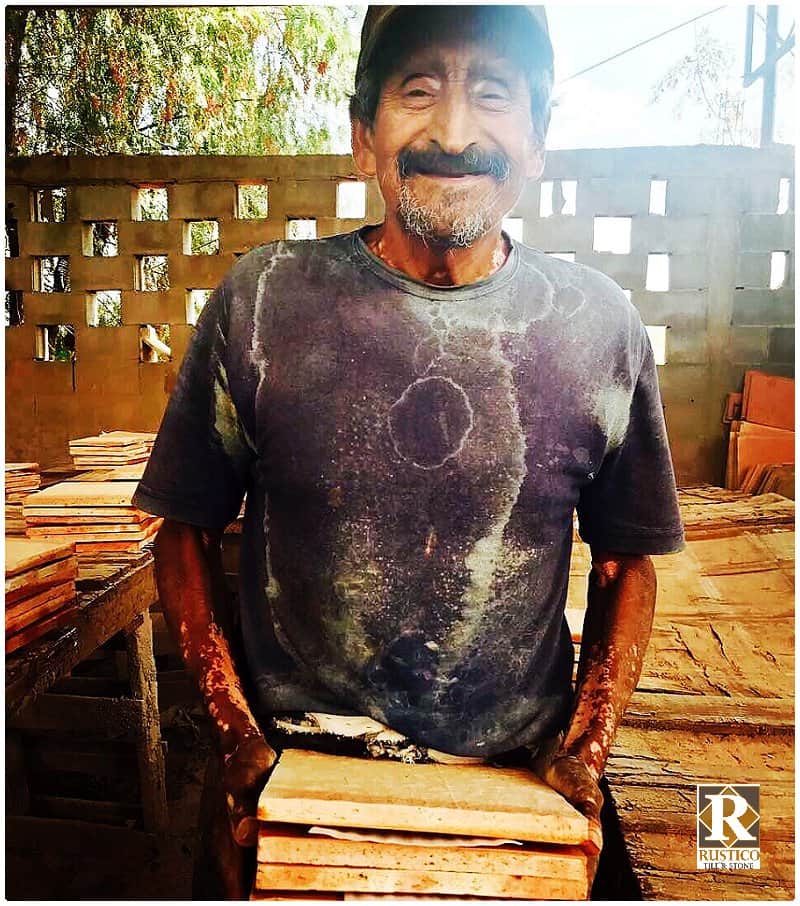
Furthermore, when inclement weather strikes Saltillo, Mexico, it impacts production speed. As an illustration, producers must plan kiln-firing around rainstorms. Otherwise, they risk the loss of entire kilns of flooring if a significant storm occurs during the firing process.
⇒ Pro Tip: Due to weather and handcrafted product variables, allow ample lead time when considering Saltillo tile flooring for your next project.
What Are Saltillo Tile Flooring Shapes & Sizes?
Gorgeous Saltillo tile flooring exists around the world! Gone are the days of plain ‘ole square tiles. Today, home and business owners add value and beauty to their spaces with decorative shapes and Saltillo tile patterns.
Let’s look at a few points about shapes and patterns.
- Square, Hexagon, Octagon, and Rectangle tiles are shapes and patterns that set the Mexican tile industry standard.
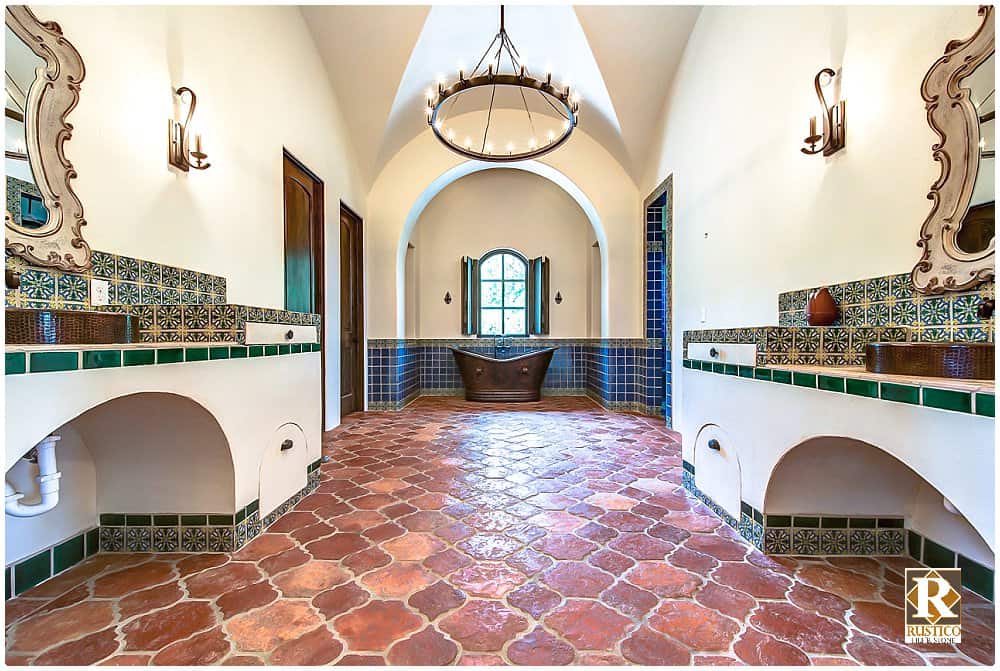
- But, there are also decorative shapes, including San Felipe (Arabesque), Fleur de Lis, Riviera Pattern (a combination of San Felipe & Fleur de Lis), Botella, Star & Cross Pattern, and Rhombus.
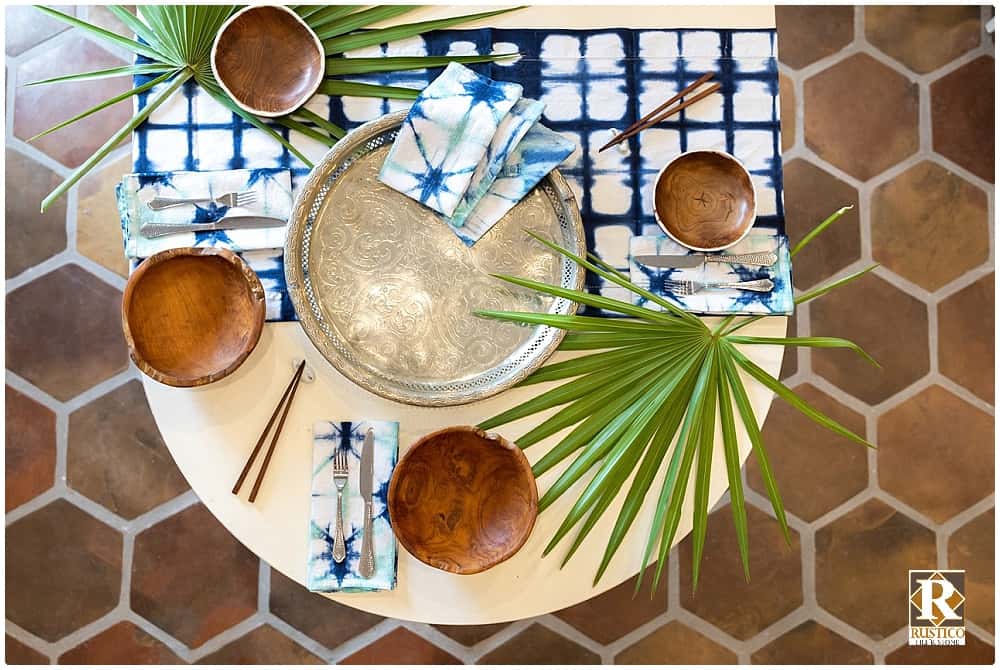
- Interior designers and architects delight in the possibilities of custom-made shapes and sizes. Producers in Mexico are open to custom projects if enough quantity is required.
- Lastly, some people refer to Saltillo tiles as Saltillo pavers. While most people think the terms are synonymous, there is a difference between a tile and a paver.
◊ For instance, most Saltillo tiles have an average thickness of 5/8”. But large format tiles have a thickness of up to 1”. During installation, set tiles on a concrete slab or prepared wood subfloor.
◊ Conversely, Saltillo pavers are approximately 2” thick and are usually unsealed. Also, install Mexican pavers in compacted soil as stepping stones or a walkway. There are limited shapes and sizes in Saltillo pavers.
When you’re in an area where Spanish-style architecture is typical, keep an eye out for various styles of these timeless terracotta floors.
Want to See It In Your Room?
Room Visualizer Tool
What Colors Does Saltillo Tile Come In?
Saltillo tile color options have expanded over the years. Overall, colors span a range of red, orange, brown, yellow, and earthen tones. More specifically, while Traditional Saltillo (terracotta shades) remain the most common, other popular options include Manganese, Spanish Mission Red, Antique, and Antique Mission Red.
Sealed versions of Saltillo display rich, saturated colors, while unsealed Saltillo flooring has pastel and light cream colors. And because it’s natural clay tile, each color choice has a range of color variations. Finally, customize Mexican Saltillo easily with stains and glazed finishes.
Digging in deeper – There are 5 color choices for Saltillo tile flooring – Traditional, Manganese, Spanish Mission Red, Antique, & Antique Mission Red.
Let’s check them out.
Traditional Saltillo Tile
colors range from light golden to dark reddish-orange
Manganese Saltillo Tile
varying shades of brown & terracotta colors
Antique Saltillo Tile
terracotta tile colors with textured surface
Spanish Mission Red Saltillo Tile
terracotta tile colors in the majority of dark shades
Antique Mission Red Saltillo Tile
mission red color range with antique textured surface
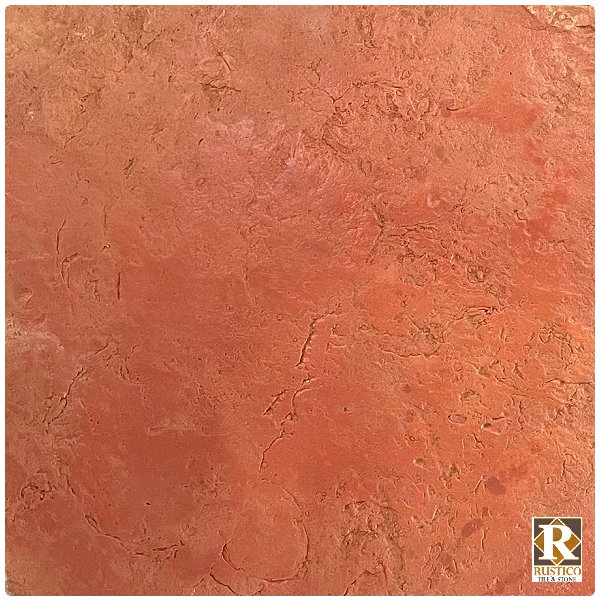
Unsealed Saltillo Tile
pastel colors of raw terracotta tile
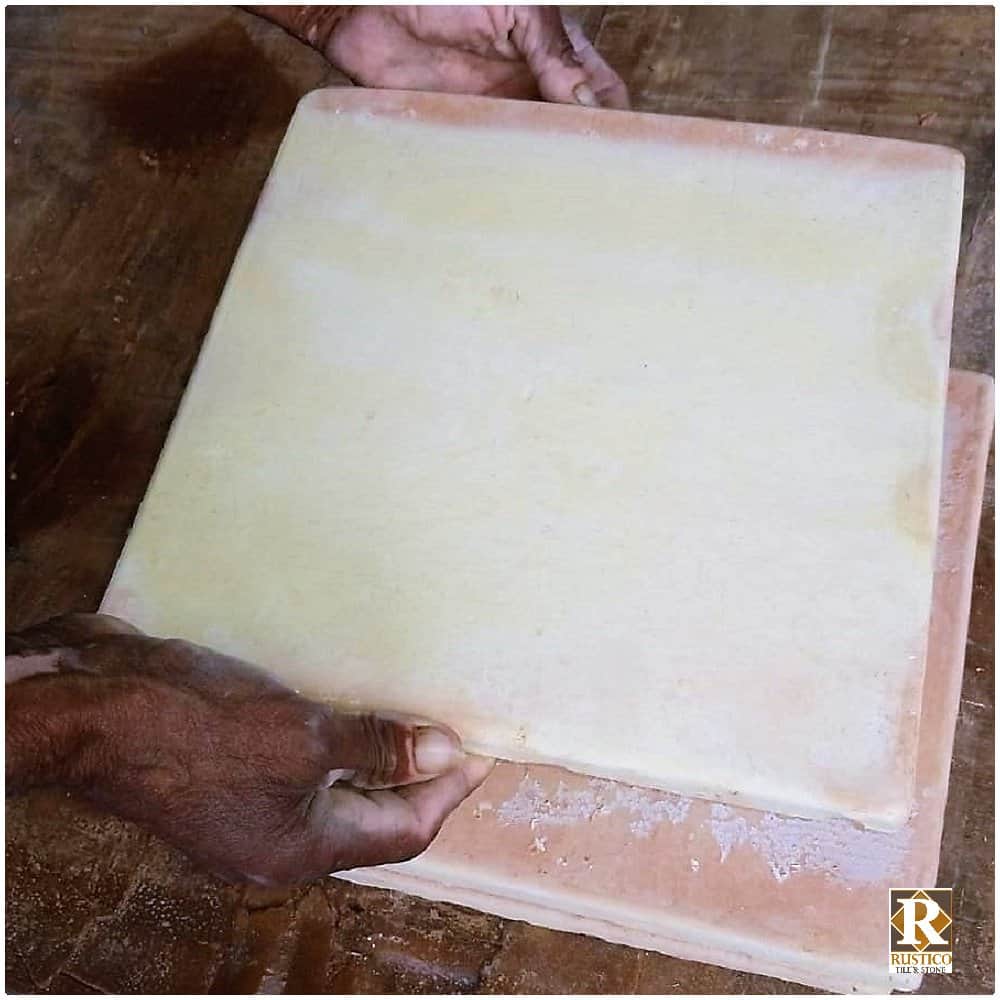
It’s important to point out that these color references are specific to presealed Saltillo tiles. Unsealed Saltillo displays raw clay pastel colors in any color finish.
Alongside these color choices, unsealed Saltillo tile is easy to custom stain to a specific color. While this is costly in labor, stain, and sealer materials, it’s a great way to get a precise color of Saltillo tile flooring.
What is the Difference Between Sealed and Unsealed Saltillo Tile?
I don’t have anything against an unsealed tile.
Except for the fact that it creates a plethora of issues. There are no time and money savings by buying and installing the unsealed tile. Ever.
Please. Just don’t.
Hear me out on a few points.
Unsealed tile is less expensive than presealed tile at the point of purchase. But by the time unsealed tile is properly sealed and installed, the project is considerably more costly than it would have been had presealed flooring been purchased. Here’s why.
- Apply 3-5 coats of a penetrating sealer to unsealed tile before installing it. Without this, Saltillo flooring stains from anything that touches the tile (lunch breaks that result in greasy hands, sloppy handling while setting the tile with thinset, grout stain, etc.).
- Many tile installers think one coat of sealer is adequate. This isn’t true. Saltillo tile is porous and requires multiple layers of sealer. Stains happen quickly if a homeowner has a partially sealed (primed) floor.
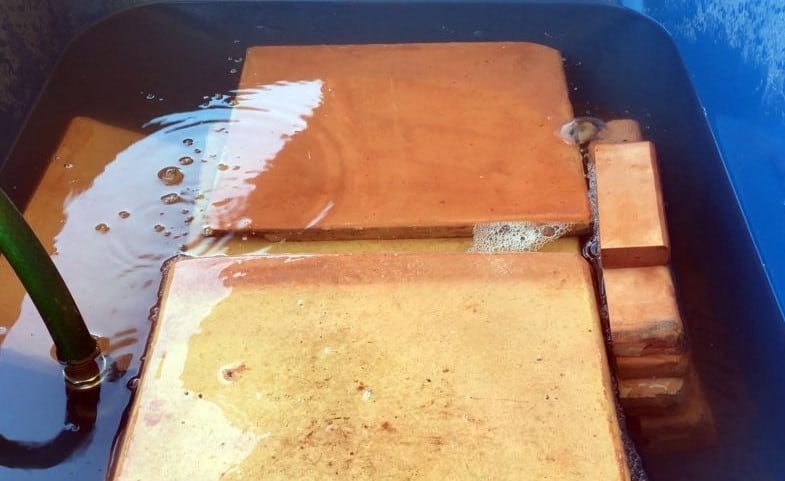
(It pains me to see this photo.)
An old method of installing unsealed terracotta tiles involves soaking them before setting them with thinset. Don’t do this. It leads to efflorescence issues that are difficult and costly to fix.
⇒ Related: Check out these 5 Things (Not) to do with Saltillo Tile Floors.
So, how do you avoid unnecessary problems and costs?
Buy presealed tile. It’s so much better for you AND your tile installer.
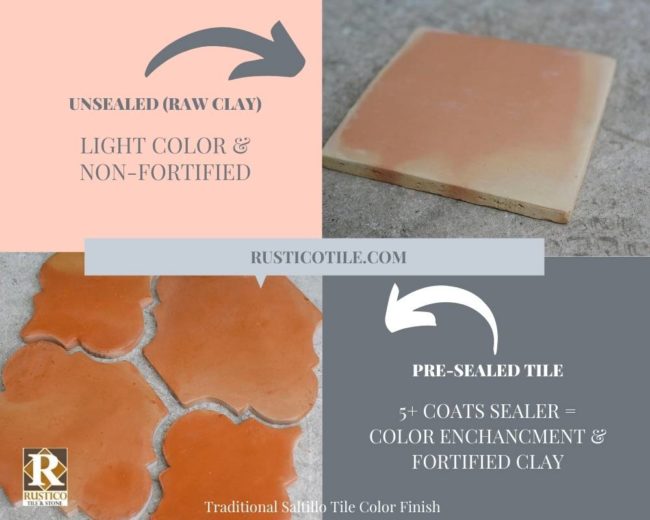
- Quality presealed tile has 3-5 coats of sealer penetrating the clay. The precise quantity depends on the type of sealer. For example, oil-based sealers are optimal for color-enhancing and fortifying clay. This is a BIG TIME quality indicator!
- Installers easily install presealed tiles without the added expense or time necessary to apply separate grout release products. Installing properly sealed flooring eliminates this step.
- Once Saltillo tile flooring is installed, apply a final topcoat sealer to protect the grout and add scratch resistance, UV protection, and water resistance. Plus, the topcoat sealer removes the scuffs that mark up tiles while they are shipped, handled, and grouted.
- Like a glossy or satin finish floor? This last coat of sealer is the cosmetic coating for a desired amount of sheen.
Is there ever a time to purchase Unsealed tile? Yes!
Buy Unsealed Saltillo Tile for projects that require custom colors. Unsealed tile can be stained or glazed for specific projects or to match up to older Saltillo tile floors. This is a go-to technique when new flooring must be modified to match an older, existing Saltillo tile floor.
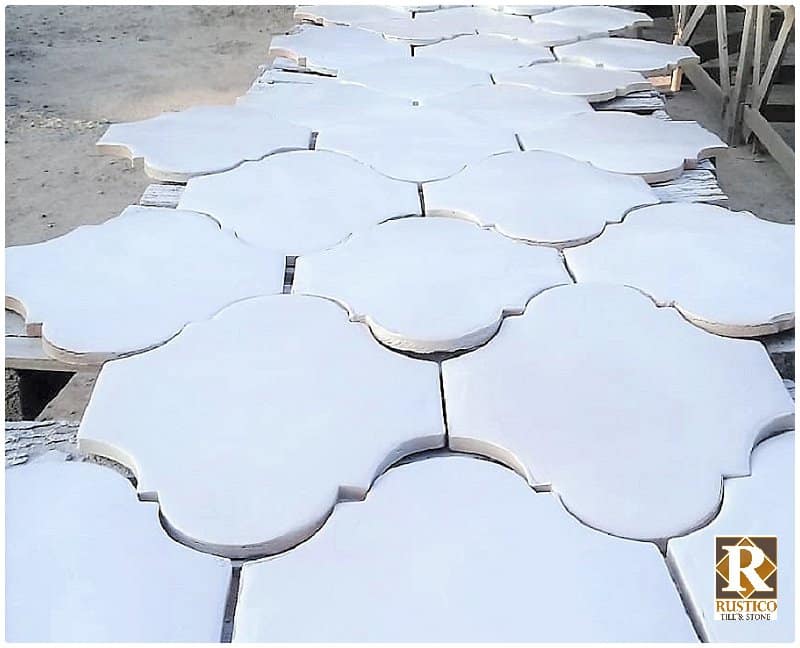
⇒ Pro Tip: Once the unsealed Saltillo tile is perfectly stained, it must be sealed with a chemically compatible sealer.
⇒ Related: Learn more about whether to buy Sealed vs. Unsealed tile.
What are the Rustic Characteristics of Saltillo Tile?
Rustic décor is a timeless trend! Fortunately, Saltillo tile flooring is an ideal flooring choice for rustic style décor spaces.
Handmade, rustic characteristics are why this Mexican tile is sought out worldwide. No two tiles are the same. They’re durable, beautiful, and affordable.
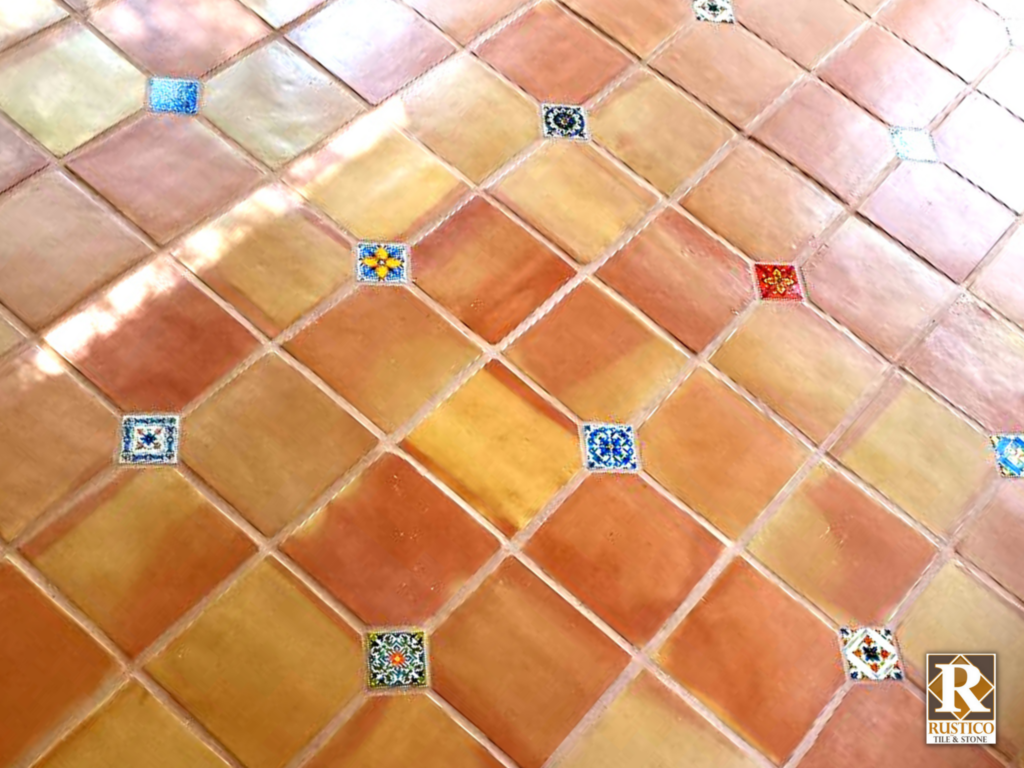
The most common rustic characteristics include (but are not limited to):
- Variations in size, color, and texture. As you reference the section above about Saltillo tile manufacturing, it’s easy to see why these variations exist.
⇒ Related: Learn more about What to Expect in Saltillo Tile Flooring
- Lime pops exist. These are minimal white and gray alkali deposits and minerals in the clay. When found at the surface of a tile, the deposits can pop (but not always), leaving behind a chip that blends into the floor. Lime pops are not defects. Instead, they’re rustic characteristics native to terracotta floors.
⇒ Pro Tip: Don’t pick at lime pops if it happens on your floor. It’s best to apply a coat of sealer over the exposed chip so it blends naturally into the rustic style of the floor. If a specific lime pop chip bugs you, replace the tile. I don’t recommend trying to “fix them.” Repair methods usually make the popped area more noticeable. My advice? Embrace the occasional lime pop for the rustic character that it is.
- Efflorescence is a crystalline salt & mineral residue that is left behind from excessive water. (Hence, don’t soak unsealed terracotta tiles as part of the installation process. The added moisture activates chances of efflorescence.) It has a powdery, white appearance.
⇒ Pro Tip: How can you avoid efflorescence? It may not be completely avoidable in natural substrates like Saltillo tile, brick, and stone, but you can prevent most of it by installing quality presealed tiles instead of unsealed tiles. Also, mitigate the chances of efflorescence in outdoor or wet areas by applying a waterproofing membrane to the subfloor.
- Also, hairline cracks, bumps, and chips are rustic characteristics found in Saltillo tile flooring. These are not defects. Instead, they are part of the handmade nature of the terracotta tile.
⇒ Pro Tip: Large format sizes include 18″ and bigger tiles. These sizes have more rustic characteristics and imperfections than 16″ and smaller sizes. These large format sizes are more pillowed and lay less evenly than smaller tiles. There are installation techniques to install these properly, of course. These factors allow for double the overage and more waste and tile selection during installation.
In summary, rustic and handmade characteristics are why Saltillo tiles are known as the “perfectly imperfect tile.”
How Much Does Saltillo Tile Cost?
The price for Saltillo flooring ranges between $3.00 – $10.00 per square foot. But also, many factors determine the exact price, including color, tile pattern, and quantity. Unsealed tiles are less expensive upfront. But due to the cost of adding coats of sealer, it’s usually less expensive in the long run to purchase presealed tiles at the onset. Lastly, expect prices above $14 per square foot for custom-glazed floor tiles.
Now to the fun stuff. Shopping!
Not only is Saltillo tile flooring durable and beautiful… it’s affordable, too!
Plus, you can get it shipped anywhere in the world. But there are a few things to know about buying Saltillo tile flooring, which saves $$$ in the long run.
First, order enough overage. Order at least 15% overage for most standard project spaces to allow for waste, cuts, and borders. If purchasing a decorative shape tile, consider 20% overage because there are more cuts in decorative shapes vs. squares and rectangles. Order 30% overage for large format sizes to allow for more waste and some tile selection since these sizes have more natural imperfections.
⇒ Pro Tip: Measure, measure, and measure again. Don’t spend excess dollars due to short-ordering tiles. Take an accurate measurement of your space. Then, add appropriate overage. Buy that amount.

Next, pick the tile pattern and size of the tile. Consider the size of your room and ceiling height as you shop for designs and sizes. By the rule of thumb, buy the largest size that a room can handle. For instance, large format tiles give the illusion of ample space. Conversely, choose small tiles for small spaces and accent areas.
Equally important is color. Choose a color finish that shoulders the weight of the design style of a room. And recognize that each color finish (Traditional, Manganese, Spanish Mission Red, Antique Mission Red, and Antique) represent a distinct range of color. So, if there are shades of color not suited to a room, buy an excess amount of overage to cull through colors on the job site. Many of our customers buy 20% or more overage (or more), so they can have some control over the color outcome of their floors.
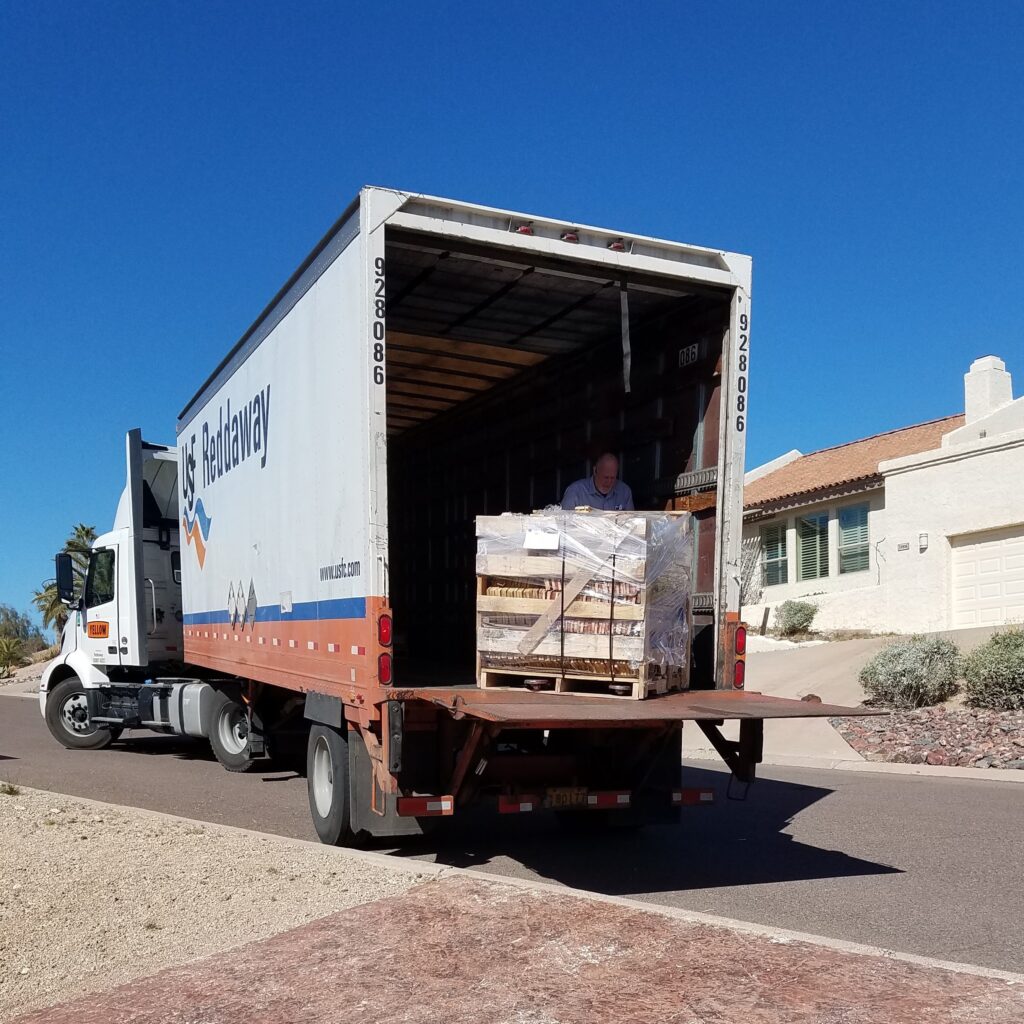
What can you expect with the delivery of Saltillo tile? Freight shipping is the best method for Mexican Saltillo flooring. If a pallet of tile is packaged correctly and handled by a professional freight carrier, it arrives in good condition. There may be a few broken or chipped tiles upon arrival. That’s normal and expected with a shipment of clay tile. So, don’t discard them. Use those few tiles as cuts in the installation.
And remember, some waste is allowed as part of the overage you purchase. It’s unrealistic to expect a freight shipment of Saltillo tile not to have a small amount of waste.
How is Saltillo Tile Installed and Maintained?
Saltillo tile flooring is a dream for any reputable tile installer. Because it’s handmade with variations in size, install it with broad grout lines that allow for a lot of flexibility.
Here are a few tips to safeguard the tile-setting process.
- Use appropriate installation materials.
⇒ Prep your subfloor. Crack prevention and waterproofing membranes tremendously reduce ongoing maintenance. Also, these materials mitigate potential installation mistakes.
- A high-quality thinset is a must. Thinset must have enough strength and flexibility properties to bond strongly to tile or stone with size and thickness variations. Don’t use cheap thinset. No one wants tiles popping up after the fact.
- Buy inexpensive grout. That’s right – save money here. Regular mortar mix is traditional grout for Mexican tile. Some other options for colored grout include sanded grout. Or add a concrete stain to the mortar mix for custom coloring.
- Invest in the best topcoat sealer available. Quality topcoat sealer protects Saltillo tile flooring and grout from scratches and stains. Plus, it makes cleaning easier!
- Clean Saltillo tile flooring with diluted chemicals or steam to preserve the lifespan of the topcoat sealer.
⇒ Related: This is our list of Recommended Installation Materials for Saltillo tile flooring.
⇒ Related: Read specific instructions about How to Install Saltillo Tile on wood and concrete subfloor.
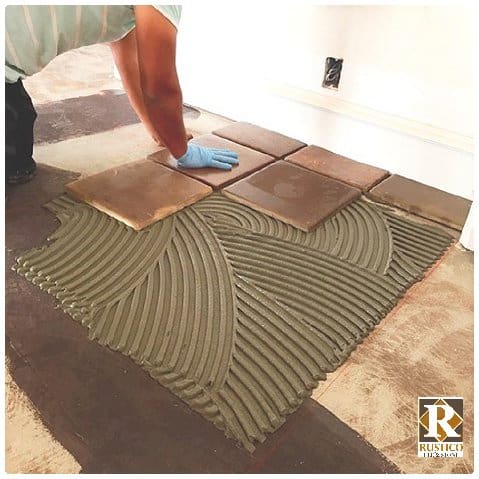
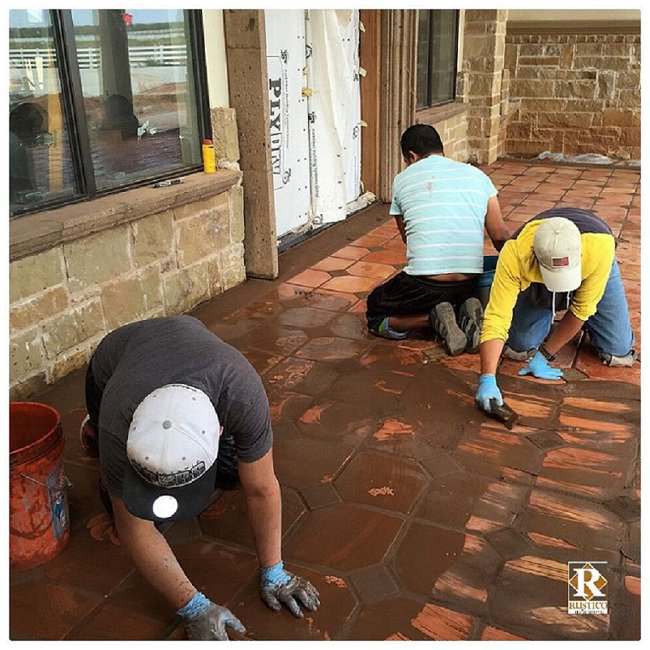
Mexican Saltillo Random Facts & Myths?
We’re in the home stretch!
There are myths and random facts about Saltillo tile flooring that you need to know.
- Fact: Saltillo tile goes by many names, including Mexican tile, Terracotta tile, Spanish tile, Mexican pavers, Lincoln Tile, Southwest tile… and my favorite, Saltilly-O tile.
- Myth: Saltillo tile has painted stripes. Nope, not accurate. While there are stripes on some tiles, these are a result of heat temperature combined with a tile’s placement in the kiln.
⇒ Pro Tip: If you don’t like the stripes, that’s ok. Consider installing them anyway because they blend into the floor’s overall look of color variation. But, if you decide against installing striped tiles, buy an ample amount of overage.
- Myth: Saltillo tile is soft. Also, not accurate because geography matters! For example, the riverbeds of Saltillo, Coahuila, represent the most durable clay in the world. And the kiln firing process and multiple coats of penetrating sealer fortify an already durable clay. Saltillo tile flooring is very durable terracotta.
- Fact: It’s impossible to have complete consistency of color in this handmade Mexican tile. It’s natural clay, so color variations exist. Always.
⇒ Pro Tip: If you desire a consistently colored Saltillo tile floor, you have two options. 1) Buy enough overage to sort colors. 2) Apply stain to customize unsealed tiles.
- Myth: Saltillo tile is high maintenance. Reduce maintenance of terracotta floors by adequately sealing the floor. High-quality sealers have lifespans of up to 10-15 years.
- Myth: Saltillo tile breaks easily. Once again, this isn’t true. The flooring is exceptionally durable. Even more so, with proper installation and maintenance, it outlasts lifetimes.
- Myth: Paw prints are a sign of good luck. I’m not sure if this is a myth or valid. Either way, random animals (dogs, chickens, cats, pigs) roam the fields where Saltillo tile dries in the sun. Folklore indicates that anyone with paw print tiles is destined for good luck.
- Fact: Most importantly, Saltillo tile is AFFORDABLE! It’s known to be a low-cost flooring option. And the low cost is not a tradeoff in quality because, as you’ve learned… it’s also excellent quality flooring!
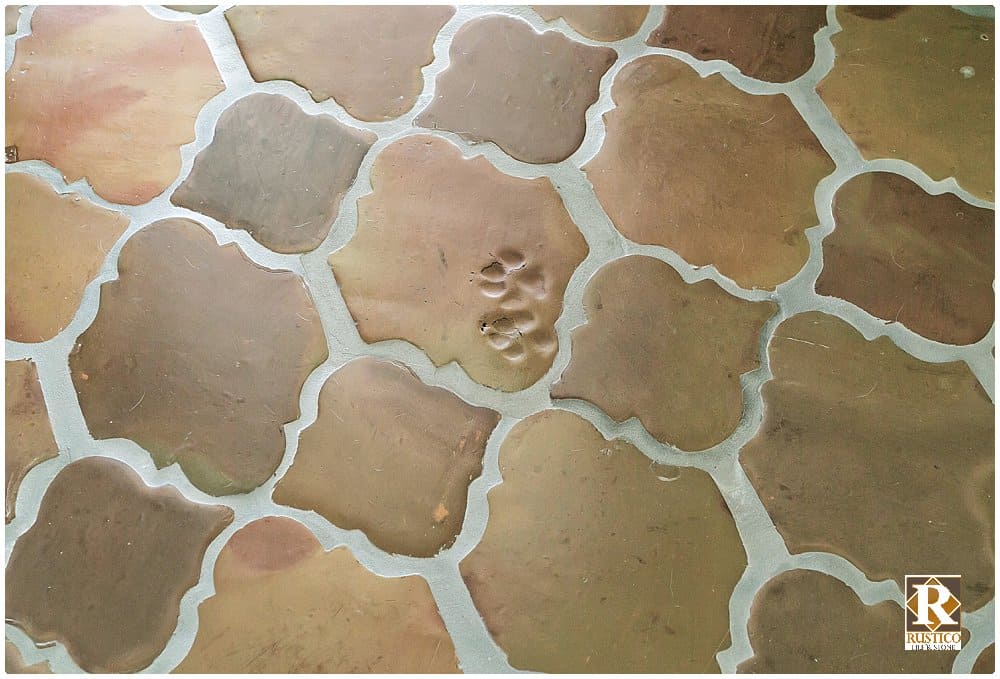
In summary, reading this article lets you know-it-all all about Saltillo tile flooring.
Do you know someone considering Saltillo tile flooring for their project? Share this article with them!
